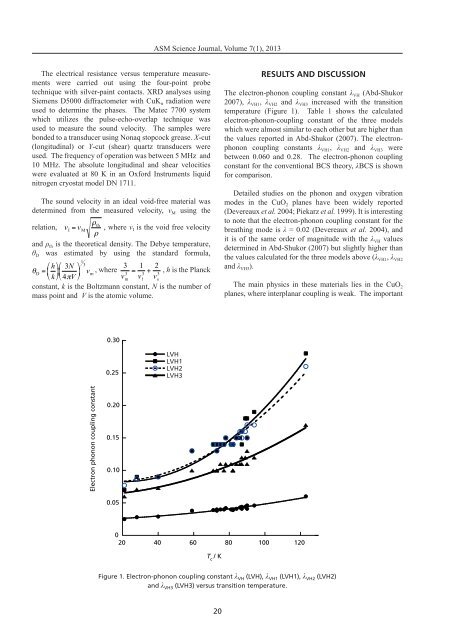Contents - Akademi Sains Malaysia
Contents - Akademi Sains Malaysia
Contents - Akademi Sains Malaysia
- No tags were found...
You also want an ePaper? Increase the reach of your titles
YUMPU automatically turns print PDFs into web optimized ePapers that Google loves.
v I= v MthASM Science Journal, Volume 7(1), 2013The electrical resistance versus temperature measurementswere carried out using the four-point probe= technique h 13Nwith silver-paint 3vmcontacts. XRD analyses usingD Siemens D5000 diffractometer with CuK α radiation werek 4 Vused to determine the phases. The Matec 7700 systemwhich utilizes the pulse-echo-overlap technique was3 used to measure the sound velocity. The samples werebonded to a transducer using Nonaq stopcock grease. X-cutv = 1 3m (longitudinal) v + 2 3 3lv s or Y-cut (shear) quartz transducers wereused. The frequency of operation was between 5 MHz and10 MHz. The absolute longitudinal and shear velocitieswere evaluated at 80 K in an Oxford Instruments liquidnitrogen cryostat model DN 1711.thvThe sound velocity in an ideal I= v Mvoid-free material wasdetermined from the measured velocity, v M using thethrelation, vthv I= v M, where v I is the void free velocityI= v Mand ρ th is the theoretical density. = h 13N 3vmDThe k 4Debye V temperature,θ D was estimated by using the standard formula,D= h 13N 3vm= h 13N 3vm 3, where , h is the PlanckDk 4 V k 4 V v = 1 3mv + 2 3 3lv sconstant, k is the Boltzmann constant, N is the number ofmass 3 point and 3 V is the atomic volume.= 1 3mv + 2 33v = 1 3 lv s mv + 2 3lv sRESULTS AND DISCUSSIONThe electron-phonon coupling constant λ VH (Abd-Shukor2007), λ VH1 , λ VH2 and λ VH3 increased with the transitiontemperature (Figure 1). Table 1 shows the calculatedelectron-phonon-coupling constant of the three modelswhich were almost similar to each other but are higher thanthe values reported in Abd-Shukor (2007). The electronphononcoupling constants λ VH1 , λ VH2 and λ VH3 werebetween 0.060 and 0.28. The electron-phonon couplingconstant for the conventional BCS theory, λBCS is shownfor comparison.Detailed studies on the phonon and oxygen vibrationmodes in the CuO 2 planes have been widely reported(Devereaux et al. 2004; Piekarz et al. 1999). It is interestingto note that the electron-phonon coupling constant for thebreathing mode is λ = 0.02 (Devereaux et al. 2004), andit is of the same order of magnitude with the λ VH valuesdetermined in Abd-Shukor (2007) but slightly higher thanthe values calculated for the three models above (λ VH1 , λ VH2and λ VH3 ).The main physics in these materials lies in the CuO 2planes, where interplanar coupling is weak. The important0.300.25LVHLVH1LVH2LVH3Electron phonon coupling constantElectron phonon coupling constant0.200.150.100.300.25 0.050.100.05Electron phonon coupling constant0.300.250.100.05and λ VH3 (LVH3) versus transition temperature.0.05LVHLVH1LVH2LVH3Electron phonon coupling constant0.300.25LVHLVH1LVH2 0.20LVH30.200.150.20020 40 60 80 100 1200.150.100.15T c/ K020 40 60 80 100 12020LVHLVH1LVH2LVH3Figure 1. Electron-phonon coupling constant λ VH (LVH), λ VH1 (LVH1), λ VH2 (LVH2)T c/ K00
















